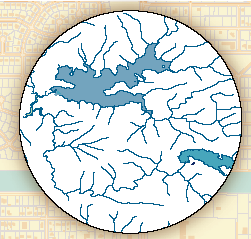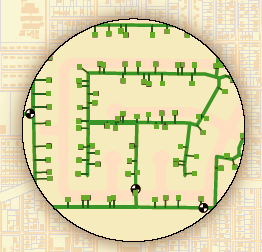In this topic
Utility and natural resource network analysis
In ArcGIS, directed flow networks—such as, utility and natural resource networks—are best modeled using a directed network (in ArcGIS, referred to as a geometric network). This type of network does not allow bi-directional travel along one of its edges (for example, pipes, rivers, electrical lines, and so on).
Transportation networks, on the other hand, are best modeled by network datasets and analyzed with ArcGIS Network Analyst extension. ArcGIS Network Analyst extension does not work with geometric networks.
River networks
Rainfall on the landscape accumulates from rivulets to streams, rivers, and finally, an ocean. The shape of the surface directs water to a stream network. Gravity drives river flow from higher elevations to sea level. The following illustration shows a river network:

A hydrologic network usually models a river as a connected set of stream reaches (edges) and their confluences (junctions). When a stream drains into a lake, hydrologic models continue the flow along an arbitrary line midway between shores until an outlet is reached.
Special large-scale hydrologic project models can include 3D analysis of flow lines through a channel volume, but simplifying a river to a one-dimension line network is suitable for most applications.
Most parts of a river network form well-drained dendritic networks with distinct channels and flow directions.
In flat terrain, river flow becomes more complicated—a large river near an ocean often forms a delta with a complex braided network—and tidal effects can reverse flow near the shore.
Some hydrologic tasks include the following:
- Deriving catchments on a surface model for each stream reach
- Accumulating rainfall on catchments and transferring flow to reach
- Using gauge values to predict flood surge along a river
- Designing a system of channels and holding ponds for high water
- Managing diversion of water for agriculture or city water works
The basic analysis done on river networks starts with estimating peak and average rainfall (from radar or model assumptions), determining how water gathers from catchment areas to river reaches, and how it accumulates downstream at confluences.
Utility networks
Utility networks are the built environment that supplies energy, water, and communications and removes effluent and storm water. Water utilities are gravity driven or pressurized, depending on terrain. Flow in a gas utility is driven by pressure in pipes. Electric power flows from high voltage potential to low. Pulses of light carry communications in a fiber-optic network. The following illustration shows a utility network:

Utility networks have a nominal flow condition, with a few sources delivering a resource to many points of consumption. Some utility networks tolerate loops, such as a water network. For other utilities, a loop is a fault condition, such as an electrical short circuit. All utility networks contain dynamic devices, such as valves and switches, that can interrupt or redirect flow in the event of an outage or system maintenance.
Some utilities, such as telecommunications and electrical networks, have multiple circuits on a common carrier (edge), such as electric lines with three phases of power or twisted-pair lines in telephony.
Some utility network tasks include the following:
- Establishing the direction of a commodity flow
- Finding what is upstream of a point
- Closing switches or valves to redirect flow
- Identifying isolated parts of the network
- Finding facilities that serve a set of customers
Utilities are concerned first with the safety of customers and employees, followed by the reliability of the system, then cost efficiency in system operations. Geographic information system (GIS) technology is an effective tool to reach these goals.
Utility and river networks in ArcGIS are modeled as geometric networks.
This analysis can be done using the Utility Network Analysis toolbar in ArcMap. Use this approach if you need to do a single analysis.
Utility and natural resource network analysis using geoprocessing
There are no geoprocessing tools to assist you in this analysis. Use ArcMap or ArcObjects, discussed in the following section, to perform these tasks.
Utility and natural resource network analysis using ArcObjects
To automate work on utility and natural resource networks, write code against the geometric networks section of the Geodatabase application programming interface (API).